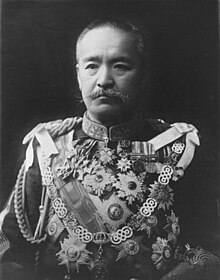Board of Chamberlains
When the kurōdodokoro (蔵人所) was installed during the Heian era, the chamberlain's role was quickly reduced, limited to matters of courtesy.The position of Grand Chamberlain was placed within the merit system in 1871, and three people—Tokudaiji Sanetsune, Masataka Kawase, and Higashikuze Michitomi—were appointed.[2] The Grand Chamberlain (侍従長, Jijūchō) is a chief functionary of the Imperial court and aide of the Emperor of Japan.The Grand Chamberlain's position is that of an attestation official (認証官 Ninshōkan), i.e. his appointment and dismissal are at the discretion of the Emperor.[3] This is a list of grand chamberlains after the Meiji period: After enforcement of the Constitution of Japan by the end of World War II:


Imperial Household AgencyTaihō CodechamberlainMinistry of the CenterHeian eraTokudaiji SanetsuneMasataka KawaseHigashikuze MichitomiWorld War II2001 Central Government ReformEmperor of JapanPrivy SealState SealMeiji PeriodCrown Prince of JapanTōgū PalaceKatsura TarōSuzuki KantarōKawase MasatakaYamaguchi TadasadaYoneda ToraoHatano NorinaoTakatsukasa HiromichiOgimachi SanemasaTokugawa SatotakaChinda SutemiHyakutake SaburōFujita HisanoriConstitution of JapanŌgane MasujirōMitani TakanobuInada SyūichiIrie SukemasaTokugawa YoshihiroYamamoto SatoruWatanabe MakotoKawashima YutakaBessho KoroAide-de-camp to the Emperor of JapanGrand Steward's SecretariatBoard of Ceremonies